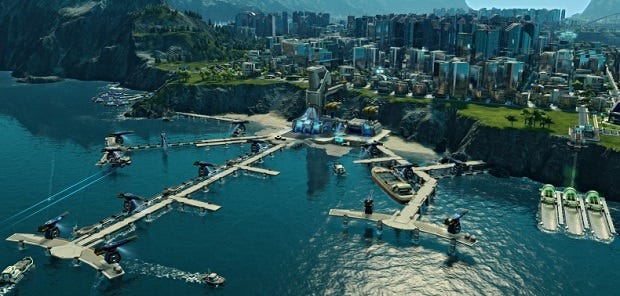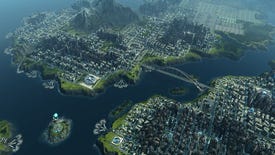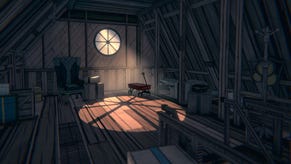Impressions: Anno 2205 Takes City-building To The Moon
Limits To Growth
"We choose to go to the Moon" says Dirk Riegert, the creative director of Ubisoft Blue Byte. Except he doesn't - he actually says something like "we will go to the Moon", which is nowhere near as good a quote, and the reason he'll probably never be elected as President of the United States.
Fabricated quotes aside, I'm in a German town called Mainz - home of the printing press and the Gutenberg bible - to see something a little more futuristic. It's Anno 2205 - the newest entry in the strategic city-building series where the numbers always add up to nine, and Riegert's explaining how this entry differs from the previous ones. "We are leaving Earth for the first time," he says. "2205? It's time for the space elevator to go up through the stratosphere."
The Anno series is mostly historical, but in the most recent game, Anno 2070, Blue Byte gazed into the near future instead - sketching out a world where 'Ecos' battled 'Tycoons' for preservation or exploitation of the planet's natural resources respectively. 135 years later, some things have changed dramatically - but some have scarcely changed at all.
The most obvious feature of Blue Byte's vision of 2205 is that mankind has colonised the Moon. Craters on the surface house colonies that send vital resources like Helium-3 and rare earth metals back to their home planet in exchange for basics like food and water. You'll build settlements up there just the ones on Earth, except that the Moon's atmosphere is far thinner than Earth's so you'll also need to erect asteroid shields.
The other major change is that you're now managing several settlements at once - different 'sessions' as Riegert calls them. At any time you can zoom out from your city view to a world (and Moon) map and select a different location to manage. Time still passes in the other locations, so you'll still accumulate resources, and trading those resources from settlements that have a surplus to those with a deficit is a crucial part of the game.
What hasn't changed is the basic Anno mechanics. You'll sketch out a city over time, progressively upgrading dwellings to new social levels (workers < operators < executives < magnates) as you supply them with resources. The more resource-gathering buildings you have, the more workers you need and therefore the more houses you build - which in turn need their own resources, and so on.
That supply-and-demand model works in a historical and near-future context, because that's what happened in history and what happens today. But extrapolating it 190 years into the future seems to me to be a little troublesome - it feels odd that there's still a distinct stratification of social class and economic confrontation between companies in a world with fusion power plants, robotic workers and seemingly no negative consequences for anything. The conflict between Ecos and Tycoons is long gone, and the only way to anger your population is to stop their flow of luxuries. Deep assumptions about society in the future - like whether growth and productivity will still be the ultimate goal of our civilisation in 200 years - seem to have gone totally unquestioned.

"It's a positive game, there's no dystopia" says Riegert when I press him on whether he's created a utopia or dystopia, and he emphasises that the studio is trying to create a world that people will want to live in rather than an accurate representation of 200 years time. Yet the faces that pop up when you click on 'miner' buildings on the Moon are black and the ones you see you click on the 'officer' residences are white. That doesn't sound like any utopia I'd ever want to live in.
A small minority of you are no doubt banging your keyboard with a clenched fist right now and shouting "it's only a game!", and no doubt it's an accidental inclusion rather than a purposeful one, so let's talk a little about how it plays. I spent about half an hour with the game in a room with a few other journalists and plenty of Blue Byte staff to answer our questions. In that time, I got to poke around an already-built city, a moonbase, and have a go at building my own town from scratch.
To begin with, it feels just like Cities: Skylines. You drag out a road, plop down some dwellings next to it, and provide power and water. Levelling up the houses requires the production of algae, so you place an algae farm. One neat thing is that most of your production buildings are expandable - you can drop down extra fields on your farm, or nodes that reduce the required staff or the energy cost. Space becomes limited fairly quickly, but happily you can move anything around at any time for no cost, which encourages fiddling with your layout.
If you're the type of gamer that loves micromanagement (and I very much am) then you'll find this sort of fiddling pretty satisfying. During my half-hour with the game, I had a fun time trading the needs of my residents off against the need for more residents. Thanks to a much larger city available to trade with nearby, many of the obstacles to rapid growth were easily hurdled and I hit what appeared to be the 'endgame' of the sandbox within that half-hour.
But maybe it wasn't just the satellite town effect that allowed me to progress so fast. Riegert says that the basic Anno formula has been "streamlined" in 2205 due to the multiple session feature. "With the previous game we hit the borders of complexity in a singular session," he says. "Several sessions in parallel [...] will get really complex when you move on, but we reduced the complexity inside a single session so that when beginners start with their first session it's more comfortable and easier for them to control it and to get used to the basic Anno gameplay."
I should mention, too, that Anno 2205 looks stunning. Blue Byte's art team have done an incredible job in making the cities look not just beautiful, but busy too. The robot factories look a little like scaled-up graphics cards, and feature conveyor belts that whizz past before your eyes. The subway stations have tracks embedded in the ground where trains come and go. An anachronistic blimp floats lazily above the stadium. On the moon, you'll see people in spacesuits bouncing happily down the street in the lower gravity.
If balancing your economy is the main-mast of Anno's splendid sailing ship, then the mizzen-mast has historically been combat, but that's firmly under wraps for now. There are intriguing-looking red icons on the world map, but we're forbidden from clicking them. Riegert promises that there will be a military aspect to the game, and it's also hinted that more terrain types than grass and lunar dirt will be available to build on, but you'll have to wait until closer to release to find out more.
Summing up my impressions of Anno 2205 is tricky. The version I played is obviously unfinished - it's a shallow but beautiful sandbox with little direction or challenge and a conflicted and incomplete vision of the future. Dropping in a compelling storyline will help, but I wonder whether the multi-session feature will actually reduce replayability - with the trade routes feature removing much of the challenge in building up a new settlement, and if the "streamlining" of the basic mechanics will go down well with long-term fans of the series.
Finally, on a personal level - and I appreciate the slight irony of writing this on a website dedicated to videogames - I find it kinda sad that Blue Byte's 'world that people want to live in' is as relentlessly focused on consumption and growth as our world today. Maybe you feel differently, and if that's the case then I'd be interested to hear your perspective in the comments below, but with the limits to growth and conflicts between exponential economics and finite physics long-established, surely anything even close to a utopia along those lines is a near impossibility?
Ah well, it's only a game.















